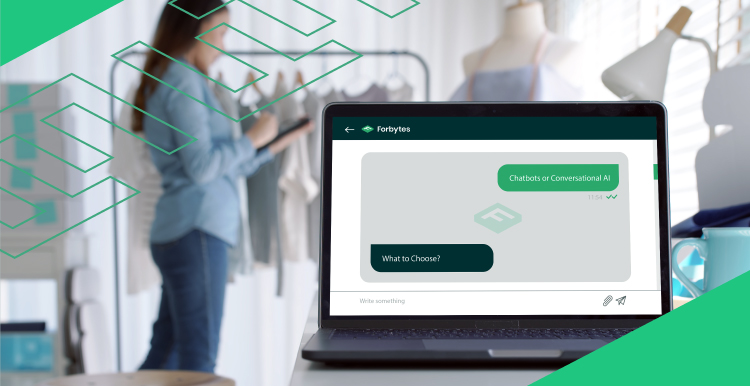In daily life, the owners of ecommerce businesses are customers themselves. So are you. Like other people, you make use of various services, buy and order goods, visit stores or e-stores, etc. And you know how important it is to be sure that your credit card data and your money are safe. The figures also show this — the value of the payment security market is projected to grow to $54.1 in 5 years. Users have a good reason to believe it will happen: in 2020, the global losses from payment frauds rose to $32.39 billion. In contrast to $9.84 in 2011, such a rise points to the importance of secure payment integration.
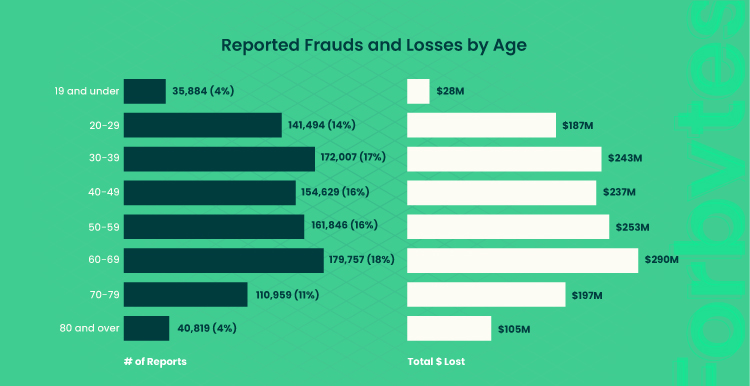
What Is Payment Gateway Integration?
The security of a payment gateway determines how many orders you get. What is it? A payment gateway solution allows for processing credit card payments online. In simple words, a gateway opens the “gate” between a device via which payment is made and a bank or payment processor. Its function is to accept payments and deliver money from a client to a merchant. Businesses integrate a payment gateway to receive payments from customers and manage financial operations online. Based on the transaction status, the system processes orders and lets clients finish the purchase.
With the right payment processing integration, you increase client trust in your e-store. Payment gateways encrypt payment details, which also eliminates security risks. To learn more about the best cybersecurity practices for ecommerce, check out our recent post. CVV, card number, expiration date, and other cardholder data are encrypted with the help of blockchain technology. The whole process of online transactions looks as follows:
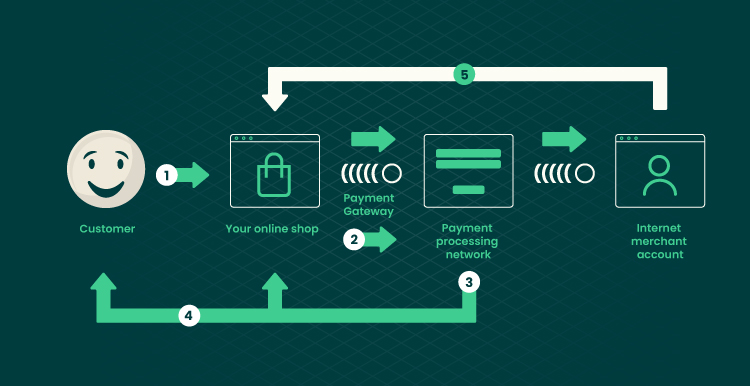
To complete a transaction, we need three main players: a client, a merchant, and the technology. We presume that both a client and a merchant have bank accounts and use technology to ensure money flow.
At first, a customer buys a product on your website. Suppose that they choose to pay with a credit/debit card. The client enters their payment details. Their data is encrypted via the SSL connection once the confirmation button is pressed. Your online shop forwards the payment details to the payment processing network using payment gateway services. The data about the transaction is sent to the card association (Mastercard, American Express, Visa, etc.) and then passed to the card-issuing bank. The bank is notified about the authorization request — it should either approve or reject it and send the response code to the payment processing network, then to the gateway, and finally to the website. If the transaction is approved, the customer sees the message about a successful payment procedure. The costs from the client account are deducted and sent to the merchant’s account. If the operation fails — the website also notifies the customer (insufficient funds are a common reason for failed online payments). On a web payment form, a client can see the progress of payment and check if they get transaction approval.
All the described may seem like a long way to go. It could be — if everything was done manually. Fortunately, modern technology automates all processes for both clients and merchants. As a result, modern payment processing takes from 1 to 3 seconds and can be named effortless.
Payment Gateway vs Payment Processor
Let’s figure out the difference between payment processing vs payment gateway. What should a customer do to pay for goods with a credit card at a brick-and-mortar store? Sure, to put their credit card out from the bag or wallet and scan it with a credit/debit card reader. A payment gateway in an online store is analogous to a credit/debit card reader in a physical store. The difference is, terminals are a part of the Point of Sale (POS) system, while a hosted payment page is designed for Card Not Present (CNP) payments. So, an online payment gateway works as a mediator that transfers the payment data from a device to a payment processor.
We may distinguish between the following types of payment gateways:
- Traditional payment gateways. These are like virtual terminals that require clients to manually enter their payment details.
- Digital payment gateways. This technology offers the same benefits as traditional gateways do. Beyond these pros, it allows for dipped and tapped payments via a smartphone or POS. Also, hosted payment gateways enable merchants to integrate transactions with various software solutions. Or they can use non-hosted payment gateways and accept online payments directly on their site.
And what is a payment processor then? A payment processor controls and manages all processes that occur after a client enters payment information and clicks the “Ok” button. The processor’s main function is to ensure data transfer between a client’s bank account and a merchant’s bank account. If we compare the function of the payments gateway vs processor, the role of the former is somewhat narrower. A payment gateway ensures that data is passed to the right place, while a payment service provider accepts electronic payments and takes care of the rest.
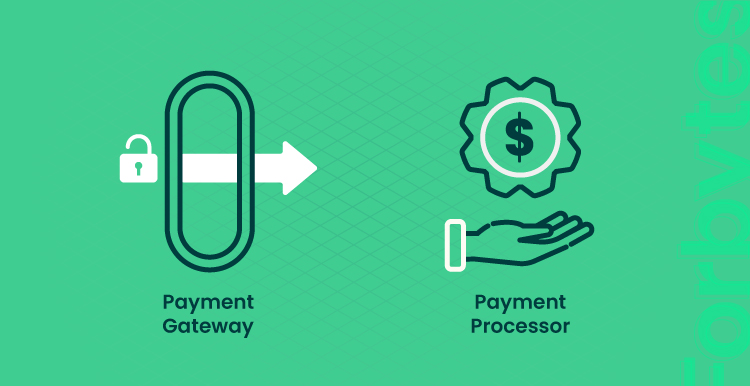
Payment processor integration cannot go without a payment gateway and vice versa. But there is no need to worry — as a rule, payment solution providers offer both functions. In the next sections, we will show you how to choose the right hosted payment provider and how to integrate a payment gateway into a website to increase your client’s trust.
6 Ways to Receive Payments from Clients
Integrating a payment gateway into a website is a responsible task. The more options you provide, the more chances to hit the target and offer your customers a payment solution that they are confident of. Usually, businesses use multiple payment methods for client convenience.
Credit and debit cards
Be it American Express, Visa, Mastercard, or another credit card company, there is no denying the popularity of credit cards. In North America and Western Europe, credit cards are one of the most popular online payment options. The study conducted by the Federal Reserve Bank of Atlanta showed that on average, US citizens made 60 payments per month in 2020. Out of these 60 payments, 23 were made with debit cards and 18 — with credit cards. The rest were done in cash.
The difference between a credit card and a debit card lies in the fact that credit card owners use money that belongs to their bank. They “borrow” the bank’s money in the form of credit — this is why the card is called a credit card. Debit cards use money that is already stored in the user’s bank account. Credit cards are believed to have better fraud protection, even though banks may charge a higher transaction fee for their use.
Bank transfer
Some eCommerce websites offer the option of accepting payments directly from the customer’s bank account. This is called a wire transfer. Under a wire transfer, there also are two players involved: a customer who transfers costs and a merchant who receives them. The transaction is done in the IBAN format, which allows ecommerce businesses to apply this payment method to the international audience. Among the benefits of wire transfers, we may distinguish speed, user-friendliness, and universality.
The Global Findex Database shows that 69% of the global adult population have a bank account. However, the popularity of wire transfers depends entirely on the bank in question. If a bank or a BaaS provider has not designed its services for international payments, a customer might give up mid-process. But as a rule, established banks in each country offer such an option. To integrate online payment on your website, add free ecommerce plugins to your platform. They will connect your online store with a service provider of your choice.
Mobile payment
Mobile-first strategy for software engineering is gaining momentum. In 2020, the global revenue of mobile payments hit $1.3 trillion. In the same year, nearly 900 million mobile payment users appeared on the market. Analysts relate this tendency to the rise of the pandemic. Yet, social distancing is not the only benefit offered by mobile payments. Mobile transactions are quick, convenient, and effortless. The growing demand for mobile ecommerce is even named one of the latest market trends. Thus, we may assume the number of people using smartphone payments will only be rising.
Any payment made with a mobile device is a mobile payment. There are different payment models, ranging from e-wallets to direct operator billing, where the payment is added to the mobile phone bill. This payment method is frequently used for micropayments. It is also a popular option for people that don’t have a bank account. Also, a common practice is to have a mobile payment app instead of owning a credit/debit card.
E-wallet
An e-wallet, or a digital wallet, is a subcategory of mobile payments. This is an online payment service where money is either deposited into an application before purchasing a product or drawn from a linked bank account. Well-known e-wallets include Amazon Pay, Google Pay, Apple Pay, Samsung Pay, etc. In 2020, the approximate number of mobile payment users reached 92.3 million. In 5 years, the figure is projected to grow to 125 million. Meantime, almost half of mobile payment users (44%) use Apple Pay, 31% use Starbucks, and 25% — Google Pay.
Digital wallets are most frequently used by millennials and gen Z. Meantime, baby boomers and seniors prefer more traditional payment methods. To know for sure whether you need to integrate e-wallet payments into your ecommerce store, conduct research on your audience.
Cash on delivery
Cash on delivery (COD) lets your eCommerce customer order a product from you and pay the courier at the moment of delivery. Any item that is not paid for is returned to the retailer.
The main advantage of COD is that a buyer doesn’t have to own a credit card. Additionally, as payment is made at a later date, this option leads to an increase in impulse purchases. In the regions where credit cards dominate, cash on delivery is unusual. Yet, it is a frequently preferred eCommerce payment method alternative in many regions, including India and the Middle East. If your eCommerce customers live in a part of the world where COD is common, then you need to offer it as a payment option. But for this, you need a reliable courier service that accepts cash. Make sure to do your research before deciding on a company.
Cryptocurrencies
If your eCommerce customers are tech enthusiasts, accepting cryptocurrency can be a worthwhile investment. This payment method is considered more secure than paying with credit/debit cards. The thing is, cryptocurrencies do not use a centralized hub. They are based on blockchain technology where client data is stored in a crypto wallet. While using this method, you do not need to pass third-party verification, which reduces the chances that someone will steal your user identity.
Here are some important characteristics of this payment method. Cryptocurrency transactions cannot be canceled. That is, if a payer has sent their money, only a payee can refund it back to their account. The process is done manually and requires businesses to keep track of all client operations. Still, a great benefit of cryptocurrencies is lower transaction fees compared to other methods. While some providers require a 1% fee, others may offer a lower fee or no fee at all.
How to Set Up Online Payment for Business? 5 Steps
Integrating a hosted payment gateway into a website may be a tricky task. On the one hand, there are many different payment gateways to choose from. On the other hand, you need to complete all steps in the checklist to make sure that the payment option of your choice works well.
1. Define your audience
No matter if you choose a custom gateway or third-party services, you need to know who your customer is. This is because preferred payment options vary a lot from country to country. So, get to know your audience better: where they live, what payment options they use, and what devices they use to access your website. For example, if you have a lot of mobile customers, then a good idea will be to offer Apple Pay or Android Pay.
2. Review different service providers
We will discuss them in more detail in the next section. Still, your choice should be determined by the convenience a provider offers to you and your audience. Study the gateway features: whether the provider uses an SSL connection, whether it is PCI DDS compliant, and whether it enables card code verification. Also, pay attention to the availability of online transactions and the supported formats of credit and debit cards.
3. Check the fees
Go to the website of a service provider and study its fees. You need to consider the fee per transaction to make sure that your decision is rational. If, for example, you sell low-cost products, high fees may adversely affect your profit. Also, check whether a provider requires setup fees and monthly fees and what types of plans it offers. And how much does an international transaction cost?
4. Check country, feature, and integration availability
If you have studied your audience in Step 1, you know what countries are your end goal. This information will be very useful when choosing a payment gateway provider since many of them have limited accessibility across the globe. For instance, while Stripe is available in 46 countries, 2Checkout works in more than 200 countries. Also, you need to check whether the chosen payment gateway can be integrated into your ecommerce platform or website and whether it has all functions you need.
5. Check the statistics in the countries you target at
Be careful: even if the preferable payment method is available in your target country, it does not guarantee that your customer is ready to use it. The thing is, some payment methods may be available but not very common in a given country. The best way to make sure that your choice is right is to refer to statistics. This approach is a part of the data-driven strategy for decision making where choices are made based on the data analysis. Below, we will introduce the most popular payment gateway providers and mention their strong and weak sides.
Top 5 Payment Gateway Providers
Businesses sometimes decide to build a custom payment gateway. Meanwhile, there are some popular payment service providers used worldwide. Let’s compare them:
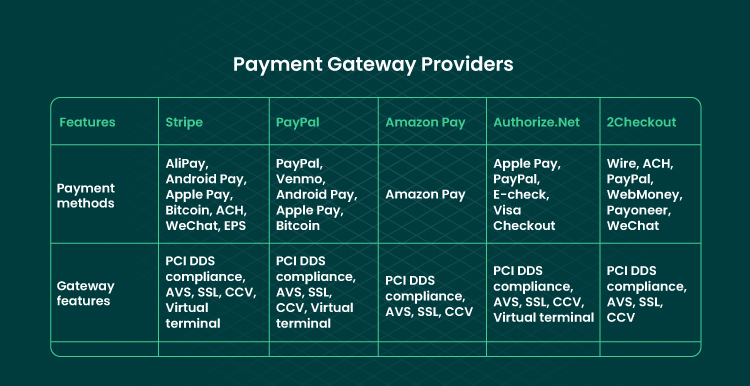
Stripe
Amazon, Google, Zoom, and Microsoft use Stripe for payment and subscription management. In total, we have more than 3 million live websites that are Stripe’s customers. Stripe is a cloud-based service for making online transactions used worldwide. It serves as a mediator between businesses and clients, handling all background processes of electronic payments. These processes include ensuring data security, money withdrawals, regular credit card payments, etc. Money transfer can be done in many currencies. Stripe also offers the function of invoicing, tax calculation, subscription payments, and billing.
Stripe is known for its stability, as the platform offers instant payments with no bugs or delays. The API offered by Stripe has a resource-oriented URL and HTTP. It enables developers to detect code errors easily and ensure robust payment functionality. The fees Stripe charges are 1.4% + $0.20 for European cards and 2.9 % + $0.20 for non-European cards.

PayPal
With 426 million active accounts worldwide, PayPal payment is one of the most popular and trusted eCommerce payment methods. PayPal provides both payment gateway and merchant account services. This makes it a convenient option for sellers. You can choose between PayPal Express Checkout, Standard, or Pro, which differ in flexibility and convenience.
PayPal also handles disputes between sellers and buyers whenever a problem arises. However, the service charges you a transaction fee for money coming in and out of your account. This can make it an expensive eCommerce payment solution for merchants that sell low-cost products.

Amazon Pay
Amazon Pay lets your customers use their existing Amazon account to pay you. Through it, people can use any payment method available on their Amazon account, except for Amazon gift cards. It only requires users to log in, making it a quick and easy option. Like PayPal, Amazon Pay offers both payment gateway and merchant account services.
Amazon reached 200 million active Prime members globally at the end of 2020 — a significant increase from 100 million in 2018. Interestingly, approximately 112 million of those members are based in the US.

Authorize.Net
Authorize.Net is a payment system that is most often used in the retail industry (12%) in the US. As of now, more than 100 000 websites entrust their financial operations to this service provider. Among the strong sides of Authorize.Net, we may mention 24/7 client support and pricing. This explains why it’s the common choice for companies having 1 to 10 employees and $1 million yearly revenue.
Authorize.Net can also be used by subscription-based businesses as it provides the function of recurring payments. You will only need to set monthly billing to receive regular payments. As for its drawbacks, here we may mention an outdated interface on the admin side and the absence of a free trial.

2Checkout
This is an electronic service that makes it easier for companies to reach a global audience. This provider accepts payments from more than 180 countries and reduces the complexities a merchant has to go through while running an international business. 2Checkout supports 60 integrations, including WordPress, Bigcommerce, Magento, Shopify, and many others.
The strong side of the platform is that it is designed with user conversion in mind. The functionality is fully adapted to the local requirements of the countries in which 2Checkout operates. It can be proved by the variety of languages, payment methods, and currencies available. Some other benefits of 2Checkout include a customized checkout page, easy integration, and secure transaction.

Let’s Sum It Up
Each step of online shopping should be easy and intuitive. After all, convenience is one of the main attractions of ecommerce. This condition requires you to design your eCommerce website with care. Your online store should be easy to navigate, easy to access on mobile, and, obviously, easy to use for purchasing goods. This means that choosing an integrated payment gateway is a very big deal.
In brief, you should choose a secure online payment gateway integration and pay attention to PCI compliance. This will help you reduce the number of abandoned carts and boost sales. Setting up online payment options is typically easy. But if you need help, get in touch with ecommerce development experts. Forbytes have plenty of experienced developers who can gladly lend you a hand.




